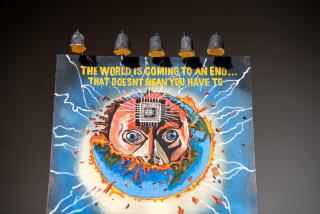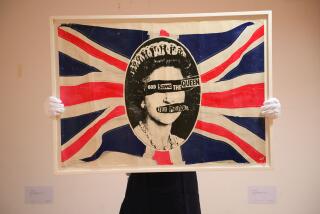A Blast From Rock’s Day-Glo Past
- Share via
BALTIMORE — Forget the Rock and Roll Hall of Fame.
If you’re looking for rock ‘n’ roll’s past in its funkiest, rawest Day-Glo glory, look no farther than Globe Poster in South Baltimore.
When it started in the early ‘30s, Globe mainly produced posters for vaudeville acts, movie theaters, burlesque houses and carnivals.
But as rock ‘n’ roll broke out in the ‘50s, the company heeded the calls of music promoters, who grew to depend on the trademark Globe Poster look: strips of alternating fluorescent colors, floating black-and-white photos and solid black type, often in different styles.
It’s marketable Pop Art, advertising some of the best-known and not-so-well-known performers of the past and present in the fluorescent ink known as Day-Glo, whose use the company pioneered. Ike and Tina Turner, B.B. King and James Brown are among Globe’s well-known subjects.
Today, Globe does promotions for such artists as Beck, Ani DiFranco and modern reggae acts.
Since 1975, Globe has been a family owned business run by Baltimore-area native Joseph Cicero Sr., 81, and his three sons, Frank, Bobby and Joey.
“We are preserving something that was in the past, but also we know that we’re paving the way for the future as well,” says Frank Cicero. “Since I’ve been here, we’ve introduced two generations to the art of posters. I think that the generation today has more respect for posters than 20 years ago as a preservation of an art form.”
The posters advertise events all over the South, including Texas, as well as in Chicago and throughout the Midwest--all over the country except west of the Rockies (freight is too expensive).
The best place to see the posters is in the warehouse. It’s an accidental rock ‘n’ roll museum. Thousands of vibrant, significant posters fill the fluorescent-paint-splattered space. They’re tied up in bundles, pasted on walls, dangling from rafters, stacked on towering racks or simply strewn on the floor.
Look closely and you may make out Percy Sledge peeking out of a pile, Parliament Funkadelic peering up from the floor or Janis Joplin jutting out from a cabinet.
The Ciceros are eager tour guides, pausing to explain everything in the warehouse, including the age of the antique-looking letterpresses, which they occasionally use (they date to the early 1900s). They politely allow each other to speak on their respective specialties.
It’s easy to tell why they’re so good at this business.
Like a poster, which needs several elements--colors, photos, distinctive type and accuracy--to be successful, Globe excels because of the niche each family member fills.
Frank, 53, is the manager. Bob, 50, is the jack-of-all-trades and computer geek. Joey, 55, is the numbers man. And Joe Sr., who started out as a Globe employee in 1935, is the expert. He has, after all, had 63 years of experience. He technically retired eight years ago.
“They gave me a retirement party,” Cicero says. “But I fooled them. I came to work the next day.”
It’s interesting that the product Cicero started with more than half a century ago has taken on even more significance today: For a retro-rabid country, concert posters are not only business but also pleasure.
Just shine a little black light, and you’ve got everything: fashionably dated stars, music and hypnotic colors.
Globe posters have shown up at Sotheby’s auctions. And collectors from as far away as Australia call Globe, wanting to know if they have any old classics lying around and if they intend to issue reprints. As a result, Globe is issuing “Globe Poster Classics,” featuring, among others, reprints of Al Green, Howling Wolf and Otis Redding posters. Collectors have paid between $200 and $2,000 for the originals, and the reprints will sell for $10 to $75. And for bulk purchases, the Ciceros will strike deals with retailers.
To produce the classics in the identical fashion as the originals, the Ciceros are reviving aging machinery, like the hulking letterpresses.
“I am more interested in the old forms of printing than the newer ones,” Bob Cicero says. “I would never have thought we’d go back to letterpress again. And here we are, years later, resorting back to something we wanted to get away from because it was archaic.”
For the elder Cicero, the revival is a nostalgia trip, reinforcing just how much things have changed.
When Cicero started at Globe, he was a form pusher, moving wooden letter-blocks back and forth and washing them off. Then he moved on to the press. From there, he worked in the composing room, setting type. In 1954, Globe was bought out by co-owner Norman Shapiro. Shapiro made Cicero shop manager, his right-hand man.
Offset, silk-screen and automatic printing were the first modes to replace letterpress at Globe. But the biggest transition came in 1989, when the Macintoshes arrived for layout and design. It took awhile to extract the authentic Globe look from a computer.
But no matter how modern the technology is, Globe will never lose its sense of history.
Even more enviable than the company’s posters are its photo archives of Globe Poster subjects, which the Ciceros have compiled over the years.
“The sad thing about it is he was a nice-looking person,” Bob Cicero says, surveying an old picture of the Jackson 5, starring an Afro-crowned young Michael Jackson. “Now it’s hard to tell what he is.”
The posters, like the pictures, tell tales of young stars, rising and falling with the tide of popular culture.
One in particular features Paul Anka on the bottom Day-Glo strip underneath a stack of lesser-known performers. Anka wasn’t in the same place after the 90-day tour for which the poster was designed.
Globe is most famous for modernizing posters for urban blues musicians, such as Al Green and Albert King. Until Globe revolutionized the representation of black-oriented entertainment in the early 1970s, the posters tended to be plain and monochromatic.
Back then, the Cicero brothers knew about the musicians they were representing. Now, they’re not so sure.
“I don’t know half of the groups that are in. They name people and I’m going: Is that the name of a group? Is that a person or is that a thing?” Joey Cicero says.
For instance, he had no idea who multiple-award-winning pop star Beck was.
But the new Beck poster, with its scattered stars, Day-Glo orange and green colors and offbeat type, is a real standout. It’s a testament to the durability of the Globe Poster style.
“I’ll tell you, I do love the Beck poster even though it’s not a classic,” Frank Cicero says.
If it ends up on the warehouse floor in 30 years, alongside its vintage predecessors, we’ll know it’s a Globe classic.
More to Read
Sign up for The Wild
We’ll help you find the best places to hike, bike and run, as well as the perfect silent spots for meditation and yoga.
You may occasionally receive promotional content from the Los Angeles Times.






